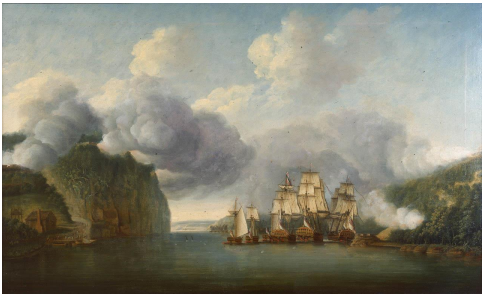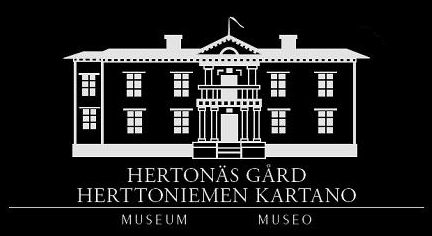The young officer Cronstedt had a successful start to his career, when he had already at the age of 19 been promoted to lieutenant of the artillery. However, he wanted to continue advancing, so he decided to go into service abroad. It was common during these times for young officers in the Swedish Navy to serve abroad. Holding exercises with the fleet was expensive, so it was more important to send the officers to fight at another fleet and thus bring the knowledge they learnt there home. Cronstedt had the British fleet in his sights, and he sailed from Sveaborg (later known as Suomenlinna) on the 1st of June 1776 on the yacht Mercurius to Copenhagen, where he boarded an English brig, Providence. The brig travelled to Yarmouth, where Cronstedt stayed for a few days, and then to London, where it anchored on the 30th of June. His first assignment was to get in touch with the Swedish ambassador, Gustaf Adam von Nolcken. Nolcken had good contacts, including with the Admiralty, and he would notify Cronstedt when an open space on a ship would come to his knowledge. Cronstedt stayed in London for a few days until von Nolcken contacted him on the 5 th of July about a free place on the frigate Perseus. Perseus was part of a convoy bound for North America, to support the British troops in the American Revolutionary War. Thus, Cronstedt's first war experience became the American Revolutionary War.
It is however good to remember that Cronstedt did not fight on the British side for any ideological reasons, as he was there mainly to gather knowledge and glory for himself. Several of the Swedish officers in service of Great Britain had even defected to the French side in the war, because its navy gave foreign officers more money, and allowed them to hold on to their higher military ranks. On which side one fought, did not primarily depend on some higher ideals, but on the best of circumstances. It however almost never happened that a Swedish officer defected from the French navy to the British side, suggesting that the conditions in Britain's service were mainly worse for foreign officers. After Cronstedt's journey to North America, would Henrik af Trolle describe in an exchange of letters with King Gustav III, how although Cronstedt had not served in the French navy, was he still an equal to his comrades for his service in the British navy. Cronstedt seems to have gotten much out of his war experience in the British Navy, which was almost certainly one of the reasons why Cronstedt served on this side in the war.
The voyage to North America was uneventful, but as the convoy began to approach the American coast, was it discovered on September the 26th that an unknown ship was in the middle of the convoy. Perseus began to chase the unknown ship, which turned out to be an American schooner, Viper. After being chased for several hours and after Perseus started firing its cannons at the ship, did it surrender. The very next morning a new American schooner named Betsey appeared, which, after it surrendered, was ordered to be taken care of by Cronstedt and a few other crewmates. When the convoy reached Sandy Hook on October the 3rd , did a major storm break out. Betsey lost the following day contact with Perseus and a few days later contact with the convoy. The crew was so small that it could not handle the situation and on October the 14th , the ship reached the coast. Perseus had reached New York that same day, but Cronstedt and the others at Betsey found themselves in New Jersey. The Americans took the crew prisoner and Cronstedt became a prisoner of war.
Cronstedt and the rest of the crew were moved to Philadelphia, which was reached on October the 23rd. The Americans allowed the prisoners to walk freely in the city, after which Cronstedt immediately contacted Baron Nolcken in London. He asked for help, but the letter did not arrive until March 1777. Cronstedt was eventually moved to Reading, where he met several other captured British officers, such as Major Campbell. After staying in Reading, the prisoners were moved first to Bethlehem, Pennsylvania, and then to New Brunswick, New Jersey. The prisoners were exchanged in the city on December the 5th and Cronstedt was finally free again.
Cronstedt served for a while on the frigate Roebuck, before rejoining the larger squadron to which Perseus belonged. The squadron sailed south to ensure that enemy transport ships did not reach the city of Charleston, South Carolina. From there it continued towards the West Indies to the island of Antigua, where the squadron entered port on February the 21st 1777. In the spring, the squadron sailed for the coast of North America, where Perseus, among other things, carried out several operations and was involved in several battles. Perseus anchored at New York harbor on August the 5th . When he arrived ashore, wrote Cronstedt some letters to his relatives, to Ambassador Nolcken and a report to the commander of the Army’s Navy, Henrik af Trolle. Cronstedt also witnessed a court-martial in New York. Two sailors had escaped, and they were sentenced to 300 lashes each. On the first of September, sailed Perseus out to sea again and during the upcoming operations was Cronstedt often assigned to take care of the hijacked ships. In April 1778, received Cronstedt his first notification from Sweden in two years. The letter was from Nolcken who expressed his happiness that Cronstedt had been freed from imprisonment. It didn’t take long before Cronstedt received another letter from Sweden. The message was from the second in command of the Finnish squadron, Carl August Ehrensvärd who called for Cronstedt to return to his homeland.

The frigate Roebuck (the first ship from the right) at the Hudson River. Picture: Thomas Mitchell.
Cronstedt planned to travel with a ship named Greyhound that was heading for Philadelphia, where it would pick up Lord Howe, the commander-in-chief of the British land forces, which after it would sail for Europe. However, General Clinton had ordered the ship to sail early due to the changed war situation and thus, Cronstedt remained stranded in New York. To his despair, the ship had sailed away with all of Cronstedt’s possessions. Cronstedt traveled on the frigate Thames, and he arrived at Philadelphia on the 4th of May. However, Cronstedt learned that the frigate Andromeda had now been appointed to take Lord Howe to Europe, so the frigate Greyhound continued sailing out at sea... with all of Cronstedt's possessions. Cronstedt asked Lord Howe to take Cronstedt with him on the Andromeda, but Howe did not give him an answer. Cronstedt was now desperately wandering the streets of Philadelphia. Cronstedt got in trouble on the 20th of May, when he was accused of being a spy, after walking by the city's fortifications. To his luck, had Cronstedt a letter to Colonel Markham, a relative to one of Cronstedt's friends from Perseus. The colonel proved Cronstedt's innocence and then invited him for some dinner.
Cronstedt contacted after some time Hammond, the captain of the ship Roebuck, at which Cronstedt had previously served. Hammond embraced Cronstedt kindly and let him sail with him on the ship. Roebuck sailed out to sea on the 30th of May and the ship participated in the many operations that arose during the evacuation of Philadelphia. After conducting military operations for about half a year, Roebuck set out for Europe on the 21st of November 1778. The ship arrived at London harbor on the 7th of January 1779, after which Cronstedt paid Nolcken a visit to thank him for his efforts during Cronstedt's captivity.
Cronstedt met in the town of Harwich a Swedish doctor named Carl Peter Thunberg, who decided to accompany Cronstedt during his journey home. The men now travelled to the Netherlands, and they arrived in The Hague on the 2nd of February. Thunberg had errands in Amsterdam, so Cronstedt toured meanwhile The Hague’s museums, theaters and he also met some new acquaintances. The men travelled in February towards Hamburg and when they arrived in Lübeck, witnessed Cronstedt the house where King Gustav Vasa had once been staying at. They soon arrived in the Swedish areas of northern Germany and in Stralsund met Cronstedt Major General Armfelt and Colonels Pollet and von Röök. The men traveled on the 11th of March, with the postyacht Sophia Albertina towards Ystad, where they arrived on the 14th of March. Cronstedt had finally returned to his homeland and in Stockholm Cronstedt reported himself to Trolle, who ordered him to write a report of his severalyear-long expedition to North America. Cronstedt asked Trolle to send him to the French fleet or to the Mediterranean to serve, but Trolle denied his request. Cronstedt's knowledge was needed in his home country and his future career was now also secured. Cronstedt would around ten years later, become famous for his efforts at the second battle of Svensksund.
Mikael Lindholm’s historical internship at Hertonäs Manor Museum is financed by the Swedish Cultural Foundation in Finland.
Sources: Odelberg Wilhelm, 1954. Carl Olof Cronstedt. Södertälje.
